Note from the CPD Blog Manager: This is part 3 of a photo essay series exploring Expo 2020 Dubai through historical context, individual country participation and public diplomacy opportunities through Expos. The author...
KEEP READINGThe CPD Blog is intended to stimulate dialog among scholars and practitioners from around the world in the public diplomacy sphere. The opinions represented here are the authors' own and do not necessarily reflect CPD's views. For blogger guidelines, click here.
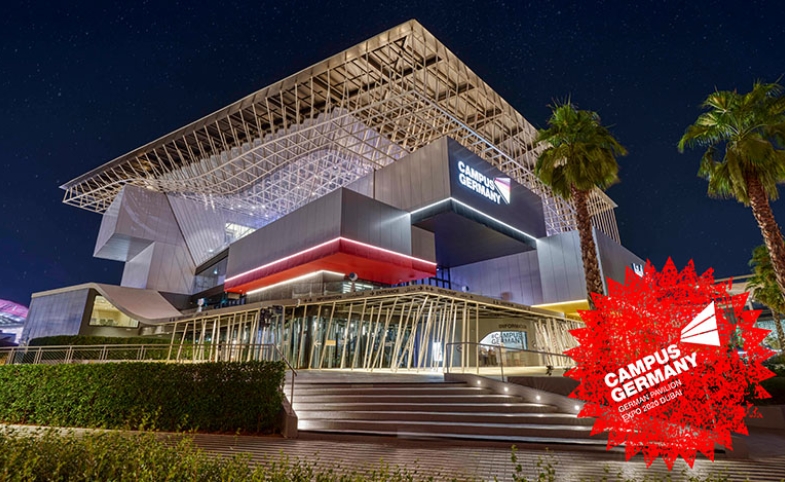
Expo 2020 Dubai: Germany: Audience, Continuity and Storytelling
Note from the CPD Blog Manager: This is part 4 of a photo essay series exploring Expo 2020 Dubai through historical context, individual country participation and public diplomacy opportunities through World Expos. The author is CEO of ExpoMuseum.com. Read part 1, part 2 and part 3.
Between November 1 and 12, 2021, I visited about 50% of all pavilions at Expo 2020 Dubai. This photo essay series will feature five pavilions from different regions to highlight best practices for public diplomacy at World Expos. These choices are by no means a selection of the best pavilions. I believe official participants in Expos are successful or unsuccessful depending on whether they bring benefits to their country’s population in the long term.
In preparation for this series, I sent a questionnaire to all five countries to be featured. The questions included cost of participation, funding scheme, participation goals, target audience, evaluation tools, etc.
We begin with Germany, the country that I believe shows the most profound understanding of the nature of Expos and the most maturity in terms of participation continuity.
Germany has consistently presented strong exhibitions and memorable innovations in recent Expos. I particularly remember the Seed Board at Expo 2015 Milan, which a colleague described as “a functioning iPad made of cardboard that you get to take home.” The Germany Pavilion at Expo 2020 Dubai contains multiple inventions to solve sustainability issues.
Germany has an understated history with Expos. Germany was the birthplace of Prince Consort Albert, husband of Queen Victoria and leading sponsor of London's Great Exhibition of the Works of Industry of All Nations of 1851. Germany also hosted the first diplomatic conference to regulate Expos in 1912. While the Convention of Berlin was never ratified, it set the foundation for the Convention Relating to International Exhibitions. Germany was one of the 11 founding countries of the Bureau International des Expositions (BIE) and has hosted two Special Expos (1957 Berlin and 1965 Munich) and one Universal Expo (2000 Hannover).
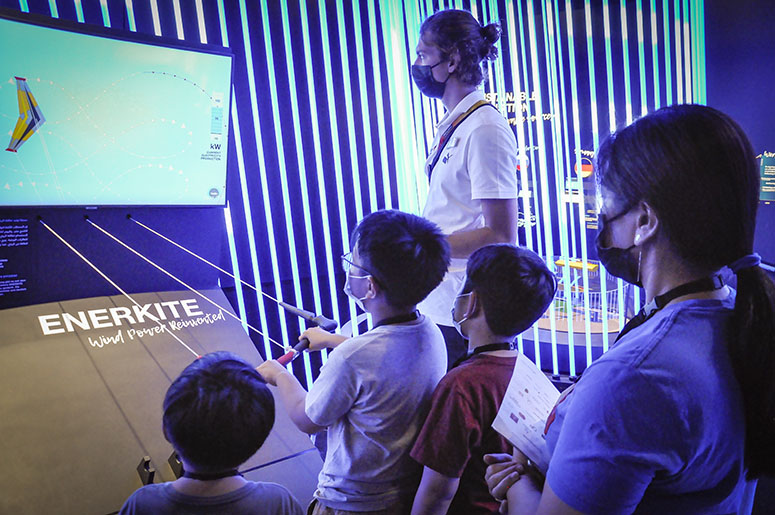
Family using an Energy Lab exhibit of the Germany Pavilion at Expo 2020 Dubai. (César Corona / Expomuseum.)
The participation of Germany at Expo 2020 Dubai offers examples of public diplomacy best practices that other countries can adopt for future Expos. The first one is Germany’s clarity about its audience. As explained in part 2 of this series, the nature of Expos is educational, not commercial. Germany understands that Expos are for the public in general, with different needs in terms of information complexity and depth.
The German Pavilion's communications team shared the following:
The Expo is meant for everyone—families with children, young couples, schoolchildren, students and senior citizens. But visitors with, for example, a professional interest in the Expo theme and the subthemes will also find a wealth of information and ideas. Some national pavilions have special areas for business meetings or conferences, but the German Pavilion has been designed primarily with those visitors in mind who simply plan to enjoy an engrossing day of Expo experiences.
Understanding its audience helped Germany delineate its funding scheme. The national section of Germany was initially allocated €50 million but increased to €58 million because of the one-year postponement of Expo 2020 Dubai. The participation was funded entirely by the German federal government, believing that private sponsorships could be detrimental.
As explained on the German Pavilion's website:
Sponsoring is not used to finance the pavilion—with good reason. Private-sector investors in projects or events want to be able to have a say in the approach taken. But if you are trying to design a pavilion that follows a storyline from start to finish, accommodating sponsors’ interests is more likely to be counterproductive.
The second public diplomacy best practice worth highlighting is continuity. The pavilion's communications team shared that Germany began preparations for Expo 2020 Dubai as soon as Expo 2015 Milan ended—even before Chancellor Angela Merkel sent the official confirmation of participation to the UAE. Germany has been using institutions and individuals’ knowledge accumulated in past Expos. The Federal Ministry for Economic Affairs and Climate Action has overseen Germany’s involvement in recent BIE-regulated Expos, and Dietmar Schmitz, a Ministry official, has been Commissioner-General of Germany in the last six Expos.
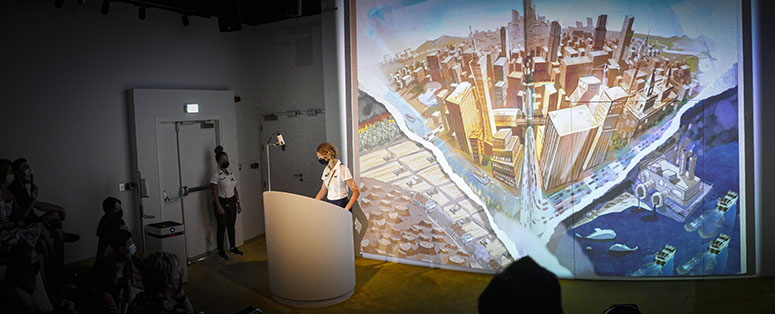
Introductory presentation of the Germany Pavilion at Expo 2020 Dubai. (César Corona / Expomuseum.)
The third public diplomacy best practice is storytelling. For Expo 2020 Dubai, Germany chose an 'edutainment' approach titled, “Campus Germany.” The pavilion’s architecture represents a college campus, where different educational sections are interconnected. The exhibition, hosted in 45,000 ft2 (4,200 m2), guides visitors through a story of formal education from enrollment to graduation.
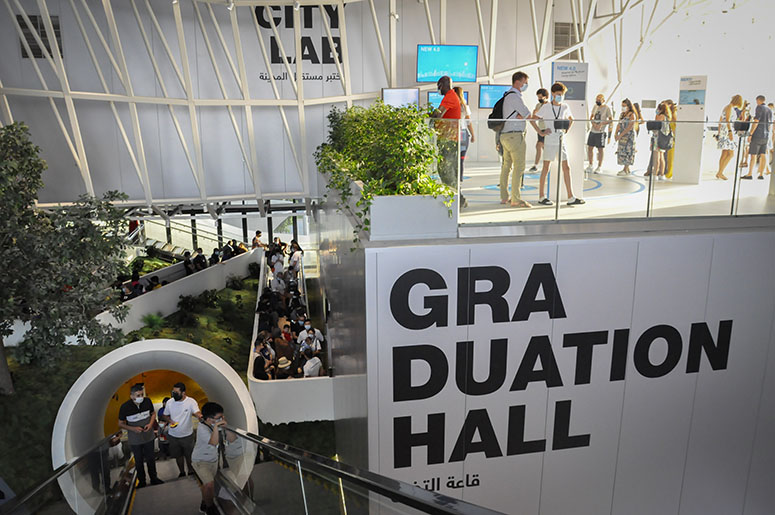
Interconnected sections of the Germany Pavilion at Expo 2020 Dubai. (César Corona / Expomuseum.)
While visitors wait in line, they have access to information about the country. Next, visitors are enrolled as they enter their name, country of origin and preferred language on a computer. Visitors then receive a badge with a sensor that customizes digital exhibits across the pavilion.
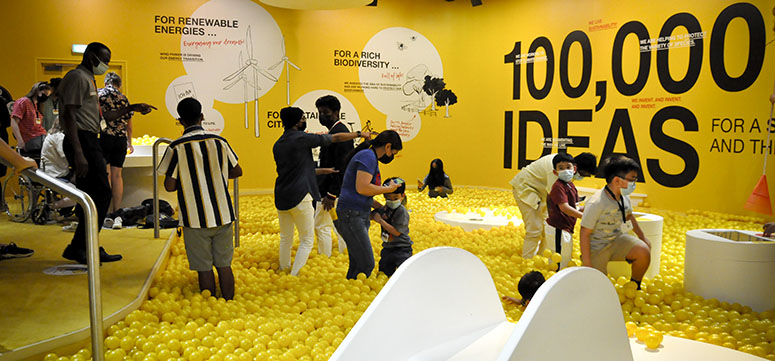
Germany by Numbers room in the Germany Pavilion at Expo 2020 Dubai. (César Corona / Expomuseum.)
The exhibition begins with an introductory show and a pit with yellow balls that symbolize 100,000 ideas. The main body of the presentation consists of three main areas: Energy, Future and Biodiversity, each with a lab and a terrace.
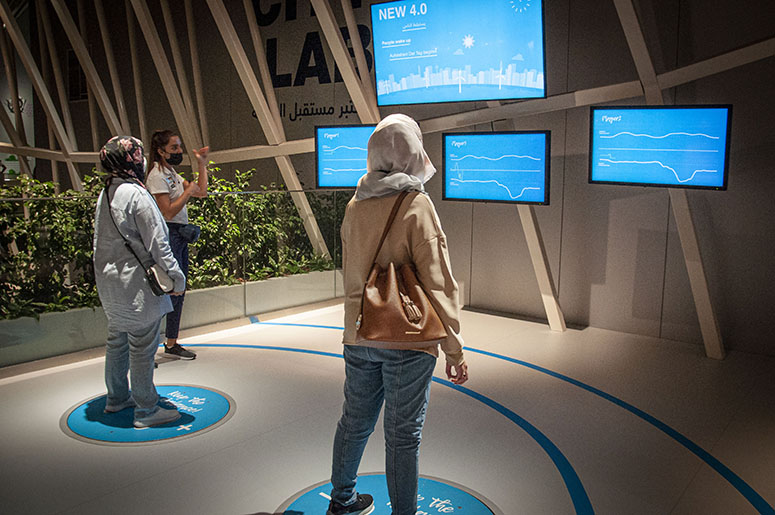
Future City Lab in the Germany Pavilion at Expo 2020 Dubai. (César Corona / Expomuseum.)
The last exhibition is housed in Graduation Hall. Here, the pavilion’s main show provides a sense of community where each person has an impact on everyone’s long-term future.
To support the overall educational process, the pavilion prepares visitors to be more receptive by offering a relaxing setting followed by a playful environment as they enter the exhibition. Then, the pavilion delivers the rational part of the exhibition across the three subthemes’ labs and terraces. Finally, the exhibition closes with an emotional show that provides a sense of completion.
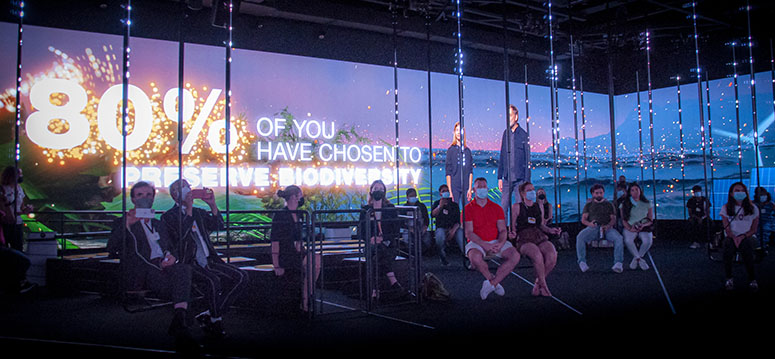
Graduation Hall in the Germany Pavilion at Expo 2020 Dubai. (César Corona / Expomuseum.)
Beyond the three best practices, Germany’s transparency sets a very high standard. To my surprise when I contacted the German Pavilion, not only did the FAQ section of the pavilion’s website already offer much of that information, but the rest of my questions were answered promptly and specifically by its communications team. The hosting staff was friendly, approachable and very honest about technical information that escaped their knowledge or about their disagreement with the assumptions of some exhibits.
Germany embraced the theme of the Expo—“Connecting Minds, Creating the Future”—and gave it a German personality. The educational approach of the exhibition embodies some of the strengths of the German educational system. Exhibits used new media to personalize and enrich the presentations, but the technology did not interfere with visitors’ experience. Information was smartly offered in layers, making it accessible to children and experts.
Aspects that could be improved include the participation’s goal and evaluation approach. Germany’s primary goal “to give visitors an unforgettable, varied and entertaining experience in our pavilion and thus at Expo 2020 Dubai, while also creating awareness of global problems” seems a bit vague and passive. For such a large project managed by a team with so much experience, I expected a more strategic and focused goal. While surveys are applied at the exit to measure success, Germany lost an excellent opportunity to learn about visitors' experiences in the long term, particularly if each visitor’s information was already captured during the “enrollment” process. The possibility to ask for an email address and permission to be contacted in the future could have allowed for surveys measuring long-term memories.
Finally, a question that remains to be asked is why the Federal Ministry for Economic Affairs and Climate Action, and not the Federal Foreign Office, oversees Germany’s participation in Expos.
I invite you to visit the Germany Pavilion virtually here and watch a video of the exhibit here.
The next post will introduce a different set of public diplomacy best practices by a pavilion that completely changed my impression of its country.
Lead photo: Germany Pavilion at night. (© German Pavilion Expo 2020 Dubai / Bjoern Lauen. Used with permission.)
Visit CPD's Online Library
Explore CPD's vast online database featuring the latest books, articles, speeches and information on international organizations dedicated to public diplomacy.
POPULAR ARTICLES
-
November 3
-
November 5
-
November 13
-
November 25
-
December 17
Join the Conversation
Interested in contributing to the CPD Blog? We welcome your posts. Read our guidelines and find out how you can submit blogs and photo essays >.













